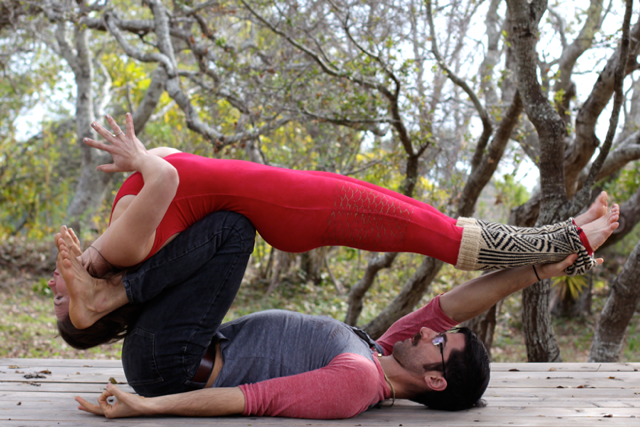AcroYoga(Yoga I want to do with my husband)
8 Things You Should Know About AcroYoga

It's
very possible you've seen a few students playing around after class or
watched a few videos online. Maybe you've seen some epic photos in a yoga
magazine of two smiling yogis balancing effortlessly on each other's
feet and/or hands in some exotic location. Perhaps, upon seeing this,
you've thought to yourself, "That's impossible! I could never do that."
Please allow me to let you in on a little secret: Yes, you can!
My
name is Daniel Scott, and I teach the Yoga of Trust. For the past six
years, I have been blessed to teach thousands of people worldwide to
literally turn their lives upside down while loving every second. As a
certified AcroYoga instructor and movement therapist, my life is
dedicated to helping others answer the question: Are you moving or being
moved?
Like any physical practice, yoga or
otherwise, AcroYoga is a dynamic offering that can seem both simple and
complex. My journey didn’t begin with gymnastics or circus arts.
Wandering aimlessly in the labyrinth of corporate life, I ran marathons
and partied ruthlessly in my "free" time in hopes of an escape before
finding yoga as a true way out. I didn’t do my first free handstand
until I was 27, and even then, I was better at falling down then getting
up.
Upon truly embracing the practice of
AcroYoga, my understanding and appreciation of yoga—and through that,
life—has deepened with immense passion and gratitude.
Whether you've tried it or not, please enjoy these following tips as
guides for the path towards building trust... within the body, the
community, and the true blessing of divine partnership.
1. AcroYoga combines yoga, healing arts, and acrobatics.
It's good to mix things up, even if it sounds like an odd recipe. All
three styles truly balance each other out (pun intended). Let's drink
straight from the source at AcroYoga.org: "AcroYoga blends the wisdom of yoga, the dynamic power of acrobatics, and the loving kindness of healing arts.
These three lineages form the foundation of a practice that cultivates
trust, playfulness, and community.” Who can say no to that?
2. You don't need a partner to find partnership.
Flying solo? No worries—you’ll find someone to soar with once when you
arrive! While you are welcome to train with a dedicated partner, there is much knowledge to be gained in mixing it up from time to time.
This partner-based practice develops your skills to work with a wide
variety of people... no matter the personality, shape, size, or skill.
3. AcroYoga is for Every Body. You
need not be a master gymnast, circus acrobat, or seasoned yogi to
enjoy. Can’t do a handstand, or even touch your toes? No big deal. AcroYoga is a practice of substance, not flash. You’ll learn necessary building blocks to literally take whatever physical skills you have to new heights.
4. Size matters not. You may think big people do the lifting, and tiny people do the flying. This is not the case. AcroYoga doesn't defy gravity, it honors it.
Technique is more important than strength. You’ll quickly learn that
muscles tire while bones don’t—whether lifting someone above your head,
pouring weight through hands for a healing touch, or counterbalancing
someone twice your size.
5. One must give to receive… and vice versa. When
was the last time you let someone else physically move you? A good
AcroYoga class creates a safe container in which participants learn the
art of allowing movement. Depending on the material taught, this could
mean total engagement, utter release, or some degree of both. Everyone
in class goes through the same experience. As you learn to support others, you end up allowing yourself to be supported. This is a fundamental of trust: take control by letting go.
6. Get what you need by asking for what you want. Unlike
practicing alone, where we spend a lot of time in our head, partner
work is deeply rooted the shared experience. In addition to honing the
skill of sharing a physical practice, AcroYoga helps to develop open,
direct, and compassionate verbal communication with whomever we’re
paired with. Try giving someone directions while in handstand. Up becoms
down. Left becomes right. Things can get mixed up when life gets
flipped asana over tea kettle. Work together or fall apart. You decide.
7. In order to know one, you must truly experience the other. The
practice of AcroYoga is split into two parts, Acrobatic (Solar) and
Therapeutic (Lunar). Each side explores the relationship between the
mover and those being moved. In the dynamic Solar practice, participants
learn three different roles: Base (mover), Flyer (being moved), and
Spotter (knowledge of both). Lunar theraputics embraces the deeply
healing connection to metta—loving kindness. Here, the Giver is the
mover, and the Receiver is the one being moved. Balance is the midpoint between extremes, so it's best to explore this practice from all sides to know where your grounded passion truly lies.
8. Trust Communication = Community. Amazing things happen when one steps outside the box, and there is no coincidence that a yoga mat is rectangular. Don't confine yourself to the soft routine of this non-slip comfort zone.
AcroYoga creates a tangible sense of tribe and celebration which is
hard to find anywhere else. Remember, it is entirely up to you how high
you want to soar or how slow you want to enjoy the process of getting
there. May these tips help further your existing practice or inspire you
to give it at try... with love, light, and flight.
Comments
Post a Comment